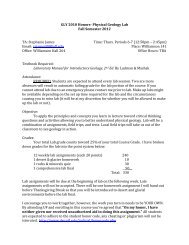Barletta et al 2010.pdf - Department of Geological Sciences ...
Barletta et al 2010.pdf - Department of Geological Sciences ...
Barletta et al 2010.pdf - Department of Geological Sciences ...
Create successful ePaper yourself
Turn your PDF publications into a flip-book with our unique Google optimized e-Paper software.
2322<br />
F. <strong>Barl<strong>et</strong>ta</strong> <strong>et</strong> <strong>al</strong>. / Quaternary Science Reviews 29 (2010) 2315e2324<br />
Fig. 7. The c<strong>al</strong>culated magn<strong>et</strong>ic declination (upper blue curve) from the CALS7k.2 model for the past 7000 c<strong>al</strong> BP (as expected for the Beaufort Sea region) and the relative ChRM<br />
declination curve <strong>of</strong> Core 650 versus depth (lower black curve). The proposed nine magn<strong>et</strong>ic declination features (D-1 to D9) as well as the available AMS- 14 C date used to construct<br />
the age model are indicated. Note that the declination sc<strong>al</strong>es are not identic<strong>al</strong>.<br />
inclination minima I-2 and I-5 still reve<strong>al</strong> a clear trend reflected by<br />
sever<strong>al</strong> data points. Regardless <strong>of</strong> these two inclination minima and<br />
in addition to the inclination maxima, the over<strong>al</strong>l correspondence<br />
b<strong>et</strong>ween the inclination curves <strong>of</strong> the different records (Fig. 9) can<br />
be ascribed to variations in Earth’s magn<strong>et</strong>ic field.<br />
The derived relative p<strong>al</strong>eointensity record <strong>of</strong> Core 650 using<br />
both k LF and IRM as norm<strong>al</strong>izers (Fig. 10) depicts similar millenni<strong>al</strong>sc<strong>al</strong>e<br />
fluctuations when compared to other previously published<br />
RPI records from the same geographic<strong>al</strong> area (Cores 05 and 803:<br />
<strong>Barl<strong>et</strong>ta</strong> <strong>et</strong> <strong>al</strong>., 2008; Core 06: Lisé-Pronovost <strong>et</strong> <strong>al</strong>., 2009; see Fig. 1<br />
for location) further supporting the derived age model. Two RPI<br />
highs at w2000 and 4000 c<strong>al</strong> BP are notably observed (P-1 and P-3;<br />
Fig. 10) and were previously recognised by <strong>Barl<strong>et</strong>ta</strong> <strong>et</strong> <strong>al</strong>. (2008) as<br />
two distinctive western Canadian Arctic chronostratigraphic<br />
markers.<br />
5. Conclusion<br />
Fig. 8. Age model <strong>of</strong> Core 650. The age model was constructed using a fifth-order<br />
polynomi<strong>al</strong> fit (R ¼ 0.999) b<strong>et</strong>ween the chronostratigraphic markers <strong>of</strong> Fig. 7 and the<br />
available AMS- 14 C date <strong>of</strong> Core 650. Uncertainties associated with the magn<strong>et</strong>ic<br />
declination features are assumed to be w100 yr according to the tempor<strong>al</strong> resolution<br />
<strong>of</strong> the CALS7k.2 model (Korte and Constable, 2005).<br />
In conclusion, our study reve<strong>al</strong>s the potenti<strong>al</strong> <strong>of</strong> using the<br />
CALS7k.2 model as a relative dating tool in the Canadian Arctic. The<br />
actu<strong>al</strong> North American database used to constrain the CALS7k.2<br />
model seems sufficient to describe most <strong>of</strong> the millenni<strong>al</strong>-sc<strong>al</strong>e<br />
Holocene PSV features observed in the western Canadian Arctic as<br />
previously highlighted by <strong>Barl<strong>et</strong>ta</strong> <strong>et</strong> <strong>al</strong>. (2008) and Lisé-Pronovost<br />
<strong>et</strong> <strong>al</strong>. (2009). Recently, Ledu <strong>et</strong> <strong>al</strong>. (in press) used similarities in the<br />
magn<strong>et</strong>ic inclination record and the CALS7k.2 output to improve<br />
the age model <strong>of</strong> a Holocene marine sedimentary sequence<br />
collected from the Lancaster Sound (eastern Canadian Arctic).<br />
Accordingly, these results open the possibility <strong>of</strong> using this chronostratigraphic<br />
approach in both the western and eastern Canadian<br />
Arctic.







